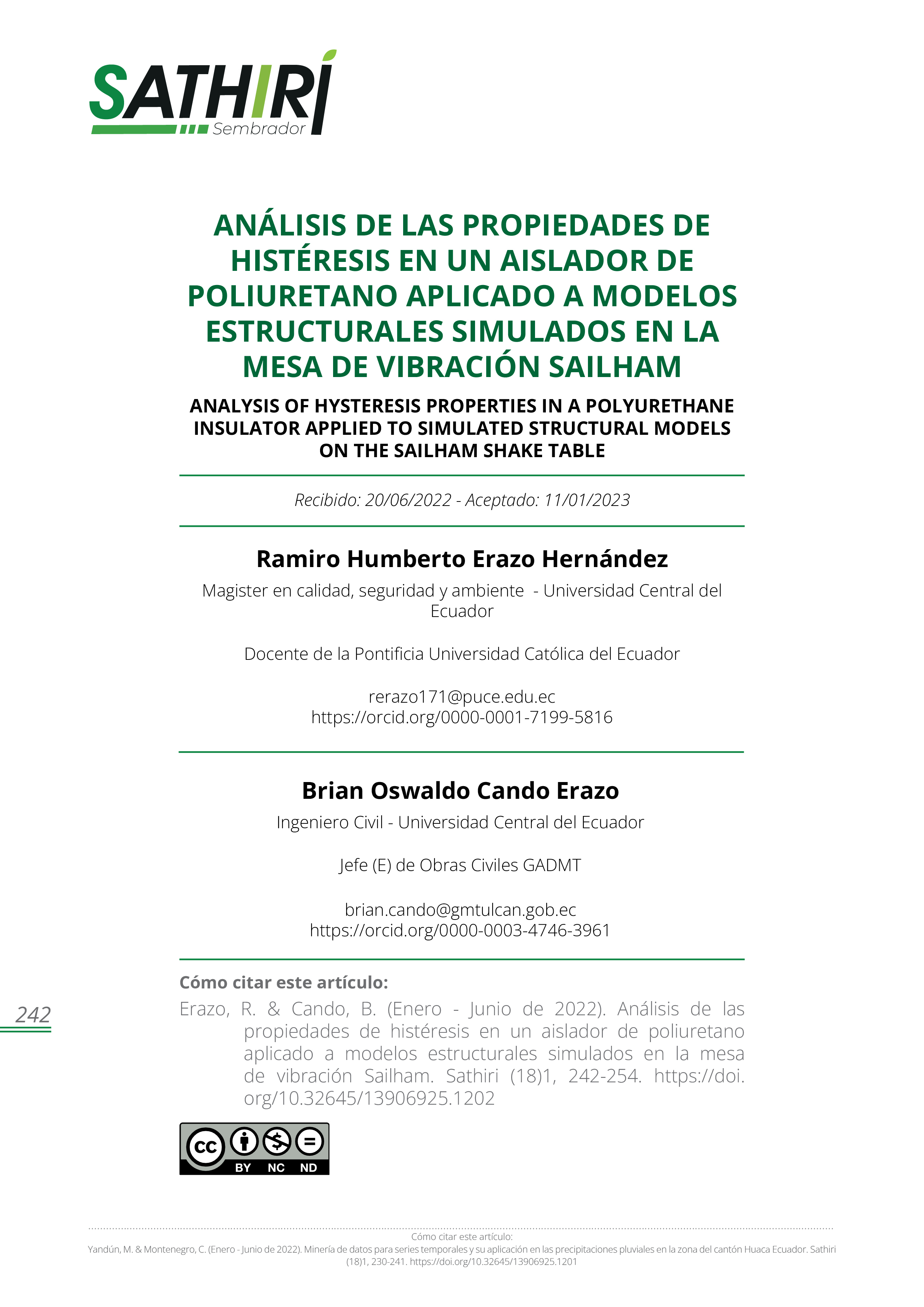Analysis of hysteresis properties in a polyurethane insulator applied to simulated structural models on the Sailham shake table
DOI:
https://doi.org/10.32645/13906925.1202Keywords:
Hysteretic properties, isolator, hysteresis curve, polyurethaneAbstract
The current investigative study aims to find the hysteresis properties of a material that allows to resemble the behavior of an insulator, it will be incorporated into three experimental models of different material and configuration. The acceleration responses were determined experimentally, by simulating on the Sailham shake table for four thrusting seismic events and four subduction events, each with two stages. To measure the acceleration responses, an accelerometer was placed on each lintel of the isolation floor. With the data obtained from the experimentation, the displacements and forces were determined through mathematical processes, in order to elaborate the hysteresis curve of the insulators of each experimental model. From the hysteresis curve, the properties of the polyurethane insulator were obtained, such as damping and effective stiffness, and with this, analyze the theory of seismic isolation.
References
Aguiar, R. (2008). Análisis Sísmico de Edificios. Primera edición. Quito: Centro de Investigaciones Científicas (Escuela Politécnica del Ejército).
Alavi & Krawinkler. (2000). Consideration of near-fault groud motion effects inseismic design. World Conf. on Earthquake Engineering, (pág. 2665). Nueva Zelanda.
Alves, M. & Oshiro, R. (2006). Scaling impacted structures when the prototype and the model are made of different material. San Paulo: Universidad de Sao Paulo.
Auqui, M. (2010). Análisis de aisladores sísmicos elastoméricos construidos en el Ecuador. Sangolquí: Centro de Investigaciones Científicos Universidad de las Fuerzas Armadas.
Bermeo, H. (2016). Determinación de espectros de respuesta y espectros de diseño elásticos e inelásticos para la ciudad de Cuenca. Cuenca: Tesis de pregrado.
Cámara de la Construcción de Chile. (2011). Antecedentes generales sistemas de protección sísmica. Informe Técnico No. 05, 1-4.
Chopra, A.K. (2011). Dynamics of Structures. Theory and applications to EarthquakeEnfineering. California: Prentice Hall.
Genatios, C. & Lafuente, M. (2016). Introducción al uso de aisladores y disipadores en estructuras. Caracas: Editor CAF.
Guamán, M. (2017). Comparación del comportamiento estructural del edificio de aulas de la Facultad de Ingeniería, Universidad Central del Ecuador, empleando el método tradicional (NEC-14) y el método de aislación sísmica. (Tesis de pregrado). Universidad Central del Ecuador, Quito, Ecuador.
Korswagen, P.; Arias, J. & Huaringa, P. (2012). Análisis y Diseño de Estructuras con Aisladores Sísmicos en el Perú. Perú: Tesis de Pregrado – Pontificia Universidad Católica del Perú.
Machado Omonte, J. C., & Quistan Jurado, J. A. (2021). Evaluación sísmica de una vivienda doméstica con el uso de aisladores sísmicos basados en la norma E030 en un distrito de Lima, 2019: una revisión de la literatura científica.
Ramos Choquehuanca, A. D. (2018). Análisis y diseño de una clínica haciendo uso de Aisladores Sísmicos en su Base.
Torres, L. (2010). Efectos de sitio observados en estaciones acelerográficas de la ciudad de Puebla. México: Tesis de Pregrado - Universidad Autónoma de México.
Vega Castillo, D. A. M. (2020). Aisladores sísmicos en el desempeño sismorresistente para estructuras de concreto armado en zonas urbanas: una revisión de la literatura científica.
Zellat, K. (2015). Influencia del sistema de aislación sísmica en la respuesta de los puentes. Ingeniería de Construcción, 210-214.

Downloads
Published
Issue
Section
License
Copyright (c) 2023 Ramiro Humberto Erazo Hernández, Brian Oswaldo Cando Erazo

This work is licensed under a Creative Commons Attribution-NonCommercial-NoDerivatives 4.0 International License.
El autor mantiene los derechos morales e intelectuales de su obra, autorizando a la editorial de la revista Sathiri la difusión y divulgación de su contenido con fines estrictamente académicos y de investigación, sin fines de lucro. Así mismo, se autoriza que la obra sea descargada y compartida con otras personas, siempre y cuando no sea alterada y se reconozca su autoria.




















